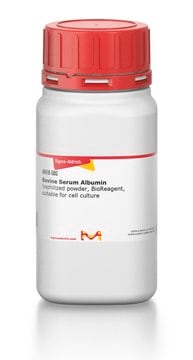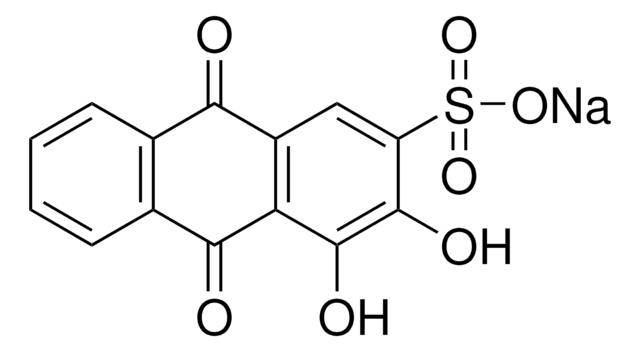AB139
Anti-Glycine Antibody
serum, Chemicon®
Zaloguj sięWyświetlanie cen organizacyjnych i kontraktowych
About This Item
Kod UNSPSC:
12352203
eCl@ss:
32160702
NACRES:
NA.41
Polecane produkty
pochodzenie biologiczne
rabbit
Poziom jakości
forma przeciwciała
serum
rodzaj przeciwciała
primary antibodies
klon
polyclonal
reaktywność gatunkowa
rat
producent / nazwa handlowa
Chemicon®
metody
immunohistochemistry: suitable
Warunki transportu
dry ice
docelowa modyfikacja potranslacyjna
unmodified
Specyficzność
Glycine
The cross-reactivities were determined using either ELISA or RIA techniques, at concentration/unconjugated or conjugated amino acid concentration at half displacement.
Compound Cross-reactivity
Glycine-G-BSA 1
Beta Alanine-G-BSA 1/100
GABA-G-BSA 1/500
Taurine-G-BSA 1/1000
Aspartate-G-BSA 1/20000
Glutamate-G-BSA <1/20000
Glycine <1/50000
The antisera was also tested for specificity using the free-floating PAP technique on rat spinal cord.
Abbreviations:
(G) Glutaraldehyde
(BSA) Bovine Serum Albumin
The cross-reactivities were determined using either ELISA or RIA techniques, at concentration/unconjugated or conjugated amino acid concentration at half displacement.
Compound Cross-reactivity
Glycine-G-BSA 1
Beta Alanine-G-BSA 1/100
GABA-G-BSA 1/500
Taurine-G-BSA 1/1000
Aspartate-G-BSA 1/20000
Glutamate-G-BSA <1/20000
Glycine <1/50000
The antisera was also tested for specificity using the free-floating PAP technique on rat spinal cord.
Abbreviations:
(G) Glutaraldehyde
(BSA) Bovine Serum Albumin
Immunogen
Glycine-gluteraldehyde-BSA
Zastosowanie
Immunohistochemistry: 1:500-1:2,500 by PAP (see suggested protocol).
Optimal working dilutions must be determined by the end user.
Optimal working dilutions must be determined by the end user.
Research Category
Neuroscience
Neuroscience
Research Sub Category
Neurotransmitters & Receptors
Neurotransmitters & Receptors
This Anti-Glycine Antibody is validated for use in IH for the detection of Glycine.
Postać fizyczna
Rabbit antiserum. Liquid with 0.05% sodium azide.
Przechowywanie i stabilność
Maintain at -20°C in undiluted aliquots for up to 6 months after date of receipt. Avoid repeated freeze/thaw cycles.
Informacje prawne
CHEMICON is a registered trademark of Merck KGaA, Darmstadt, Germany
Oświadczenie o zrzeczeniu się odpowiedzialności
Unless otherwise stated in our catalog or other company documentation accompanying the product(s), our products are intended for research use only and are not to be used for any other purpose, which includes but is not limited to, unauthorized commercial uses, in vitro diagnostic uses, ex vivo or in vivo therapeutic uses or any type of consumption or application to humans or animals.
Ta strona może zawierać tekst przetłumaczony maszynowo.
Nie możesz znaleźć właściwego produktu?
Wypróbuj nasz Narzędzie selektora produktów.
Kod klasy składowania
10 - Combustible liquids
Klasa zagrożenia wodnego (WGK)
WGK 2
Certyfikaty analizy (CoA)
Poszukaj Certyfikaty analizy (CoA), wpisując numer partii/serii produktów. Numery serii i partii można znaleźć na etykiecie produktu po słowach „seria” lub „partia”.
Masz już ten produkt?
Dokumenty związane z niedawno zakupionymi produktami zostały zamieszczone w Bibliotece dokumentów.
Interruption of pacemaker signals is mediated by GABAergic inhibition of the pacemaker nucleus in the African electric fish Gymnarchus niloticus.
Ying Zhang, Masashi Kawasaki
Journal of comparative physiology. A, Neuroethology, sensory, neural, and behavioral physiology null
S McDavid et al.
Neuroscience, 139(3), 1049-1059 (2006-03-15)
Three series of experiments were carried out to characterize interneurons located within the trigeminal motor nucleus of young rats aged 5-24 days. Cholera toxin injections were made bilaterally into the masseter and, sometimes, digastric muscles to label motoneurons. In the
Atsuo Nishino et al.
BMC neuroscience, 11, 6-6 (2010-01-21)
Rhythmic motor patterns for locomotion in vertebrates are generated in spinal cord neural networks known as spinal Central Pattern Generators (CPGs). A key element in pattern generation is the role of glycinergic synaptic transmission by interneurons that cross the cord
Heterogeneous kinetics and pharmacology of synaptic inhibition in the chick auditory brainstem.
SP Kuo, LA Bradley, LO Trussell
The Journal of Neuroscience null
J H Lue et al.
Synapse (New York, N.Y.), 41(2), 139-149 (2001-06-16)
This study was aimed to clarify whether the primary afferent terminals (PATs), GABAergic terminals, and glutamatergic terminals made direct synaptic contacts with glycine-IR neurons in the cuneate nucleus of rats. In this connection, injection of the anterograde tracer WGA-HRP into
Nasz zespół naukowców ma doświadczenie we wszystkich obszarach badań, w tym w naukach przyrodniczych, materiałoznawstwie, syntezie chemicznej, chromatografii, analityce i wielu innych dziedzinach.
Skontaktuj się z zespołem ds. pomocy technicznej






